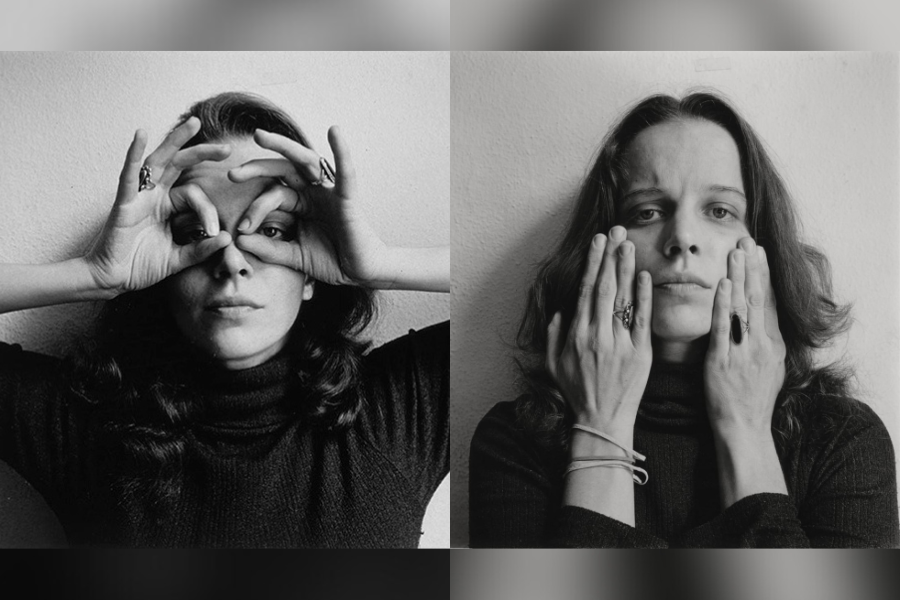Professor Emerita 梅丽莎摇’s Photography on Display at Philadelphia Museum of Art
The 1970s were defined by an explosion of creativity and experimentation. It was an era marked by societal shifts, cultural revolutions, and a reevaluation of artistic norms. Within this dynamic landscape, late 马塞诸斯州大学波士顿 Professor Emerita 梅丽莎摇 embarked on an eight-month journey of self-discovery through her photography.

That journey is currently on display at the Philadelphia Museum of Art (PMA). The exhibition, entitled In the Right Place, showcases three photographic series from the 1970s: 梅丽莎摇’s Daily Self-Portraits (1972–73), Barbara Crane’s People of the North Portal (1970–71), and Carol Taback’s Photo-Booth Strips (1978–80).
Shook’s collection comprises approximately 200 self-portraits, captured between December 1972 and August 1973. Using a medium-format camera, 三脚架, 和定时功能, Shook assumed the roles of both photographer and subject, exploring different angles and styles over time. Her photos range from solitary moments to intimate interactions with friends, 邻居, 特别是, her daughter Krissy.
“My mother photographed me every day of my life,克里西说, describing her mother’s camera as an omnipresent third hand. “Melissa never said, ‘Pose’ or ‘Say “Cheese.”’ I never grew up that way. I could do anything I wanted: crawl, scream, put on masks. We’d pose together and just have fun.”
The PMA invited art enthusiasts to learn more about Shook’s self-portraits through a virtual panel discussion last month. Dr. 莎莉·斯坦, renowned for her scholarly contributions to the field of photography, provided a contextual framework for understanding the broader cultural significance of Shook's work within the landscape of 1970s America.
“The 1970s was a time when more and more photographers made extended series of self-portraits,斯坦因说, pointing to examples like Lee Friedlander and, 最近, Cindy Sherman. “Shook preceded Sherman in a most systematic and beautiful study of herself. Her relatively small prints had such focus and tonal subtlety.”
Stein first met Shook in the early 1970s while working as a gallery assistant in New York. Although she didn’t know about Shook’s daily photography project at the time, she was grateful for the opportunity to provide commentary on it during the panel discussion.
Shook portrays herself in various poses and a range of emotions throughout the photo series, using her New York City tenement apartment as a backdrop. Her portfolio spans from moments of defiance to vulnerability, providing insight into the intricate layers of identity and the ever-changing perception of self.
“I was ultimately most impressed with an aspect that bothered quite a few others at the time: the series’ daily consistency combined with radical inconsistency at a time when young women were vigorously protesting traditional pigeonholes and stereotypes,斯坦因说. “[Shook] carefully poses but refuses to be pinned down.”
Shook’s work was published in 相机35 magazine and subsequently attracted the attention of MoMA curator John Szarkowski, who purchased a dozen prints for their collection in 1975.
The following year, Shook moved to Boston and got a job as the first female photography instructor at the Massachusetts Institute of Technology. In 1979, she joined the Art & Art History Department at 马塞诸斯州大学波士顿, where she taught photography for 31 years.
Amanda Bock ’06, the Lynne and Harold Honickman Assistant Curator of Photographs at PMA, was one of her students.
“It's great to be reconnected with Melissa here in a different context as a curator,” she said during the panel discussion.
In the Right Place will be on display until July 7. 另外, Shook’s complete self-portrait collection is on display at the Nelson-Atkins Museum of Art in Kansas City until August 4 and marks the first museum exhibition of this full series.
